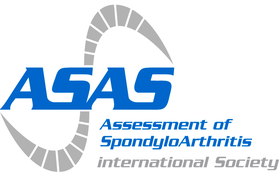Profile of:
Manouk De Hooge
I am a post-doc researcher at the Ghent University Hospital (UZ Gent) in Belgium. My research focus is on spondyloarthritis, psoriatic arthritis and imaging. In addition, I assess imaging reads for several clinical trials and cohort studies. In the Netherlands, at the Leiden University Medical Center I did my PhD training on imaging in axial spondyloarthritis under supervision of prof.dr. Désirée van der Heijde, Floris van Gaalen and Monique Reijnierse, who are all ASAS members. Currently I am the co-chair of Young ASAS.
Full name: Manouk De Hooge
Current country: Belgium
Membership level: Full
Type of membership: Member
Number of publications: 25
Association of anatomical variants of the sacroiliac joint with bone marrow edema in patients with axial spondyloarthritis. (2023)
https://pubmed.ncbi.nlm.nih.gov/37682337/
Impact of sex on spinal radiographic progression in axial spondyloarthritis: a longitudinal Swiss cohort analysis over a period of 10 years (2023)
https://pubmed.ncbi.nlm.nih.gov/37507208/
Do fatty lesions explain the effect of inflammation on new syndesmophytes in patients with radiographic axial spondyloarthritis? Results from the SIAS cohort and ASSERT trial (2023)
https://pubmed.ncbi.nlm.nih.gov/37407237/
Anaemia is associated with higher disease activity in axial spondyloarthritis but is not an independent predictor of spinal radiographic progression: data from the Swiss Clinical Quality Management Registry (2023)
https://pubmed.ncbi.nlm.nih.gov/37289315/
Extent of axial damage in psoriatic arthritis and spondyloarthritis: comparative data from the BEPAS and (Be-)GIANT multicentre cohorts (2023)
https://pubmed.ncbi.nlm.nih.gov/37137541/
Site-specific assessment of spinal radiographic progression improves detection of TNF blocker-associated disease modification in axial spondyloarthritis: longitudinal observational data from the Swiss Clinical Quality Management Registry (2023)
https://pubmed.ncbi.nlm.nih.gov/36915202/
Social Media Use Among Members of the Assessment of Spondyloarthritis International Society: Results of a Web-Based Survey (2023)
https://pubmed.ncbi.nlm.nih.gov/36626201/
ASAS-EULAR recommendations for the management of axial spondyloarthritis: 2022 update (2023)
https://pubmed.ncbi.nlm.nih.gov/36270658/
MRI lesions of the spine in patients with axial spondyloarthritis: an update of lesion definitions and validation by the ASAS MRI working group (2022)
https://pubmed.ncbi.nlm.nih.gov/35609977/
Progressive Increase in Sacroiliac Joint and Spinal Lesions Detected on Magnetic Resonance Imaging in Healthy Individuals in Relation to Age (2022)
https://pubmed.ncbi.nlm.nih.gov/35436391/
Current differentiation between radiographic and non-radiographic axial spondyloarthritis is of limited benefit for prediction of important clinical outcomes: data from a large, prospective, observational cohort (2022)
https://pubmed.ncbi.nlm.nih.gov/35110365/
The value of magnetic resonance imaging for assessing disease extent and prediction of relapse in early peripheral spondyloarthritis (2021)
https://pubmed.ncbi.nlm.nih.gov/33982902/
Structural changes in the sacroiliac joint on MRI and relationship to ASDAS inactive disease in axial spondyloarthritis: a 2-year study comparing treatment with etanercept in EMBARK to a contemporary control cohort in DESIR. (2021)
https://pubmed.ncbi.nlm.nih.gov/33514428/
Axial involvement in patients with early peripheral spondyloarthritis: a prospective MRI study of sacroiliac joints and spine (2021)
https://pubmed.ncbi.nlm.nih.gov/33115761/
Central reader evaluation of MRI scans of the sacroiliac joints from the ASAS classification cohort: discrepancies with local readers and impact on the performance of the ASAS criteria (2020)
https://pubmed.ncbi.nlm.nih.gov/32371388/
The Future of Imaging in Axial Spondyloarthritis (2020)
https://pubmed.ncbi.nlm.nih.gov/32340703/
High prevalence of spondyloarthritis-like MRI lesions in postpartum women: a prospective analysis in relation to maternal, child and birth characteristics (2020)
https://pubmed.ncbi.nlm.nih.gov/32299794/
Spinal radiographic progression in axial spondyloarthritis and the impact of classification as nonradiographic versus radiographic disease: Data from the Swiss Clinical Quality Management cohort (2020)
https://pubmed.ncbi.nlm.nih.gov/32196530/
Immunoscintigraphy in axial spondyloarthritis: a new imaging modality for sacroiliac inflammation (2020)
https://pubmed.ncbi.nlm.nih.gov/32102796/
Low specificity but high sensitivity of inflammatory back pain criteria in rheumatology settings in Europe: confirmation of findings from a German cohort study. (2019)
https://pubmed.ncbi.nlm.nih.gov/31302595/
Spinal radiographic progression over 2 years in ankylosing spondylitis patients treated with secukinumab: a historical cohort comparison (2019)
https://pubmed.ncbi.nlm.nih.gov/31174584/
MRI lesions in the sacroiliac joints of patients with spondyloarthritis: an update of definitions and validation by the ASAS MRI working group (2019)
https://pubmed.ncbi.nlm.nih.gov/31422357/
Prevalence of degenerative changes and overlap with spondyloarthritis-associated lesions in the spine of patients from the DESIR cohort (2018)
https://pubmed.ncbi.nlm.nih.gov/29955382/
Magnetic Resonance Imaging of the Sacroiliac Joints Indicating Sacroiliitis According to the Assessment of SpondyloArthritis international Society Definition in Healthy Individuals, Runners, and Women With Postpartum Back Pain (2018)
https://pubmed.ncbi.nlm.nih.gov/29513924/
Effect of mechanical stress on magnetic resonance imaging of the sacroiliac joints: assessment of military recruits by magnetic resonance imaging study (2018)
https://pubmed.ncbi.nlm.nih.gov/29329434/
